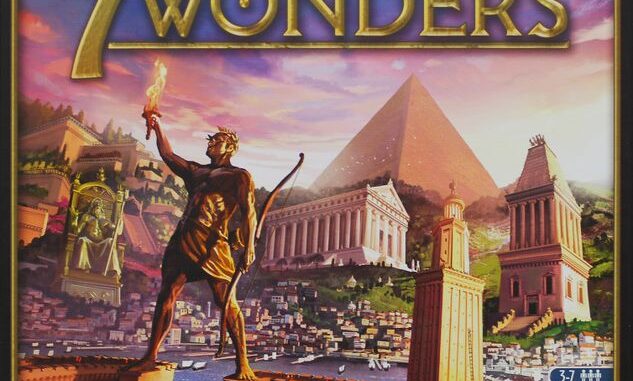
Seven Wonders is one of those games that’s been around awhile that I just haven’t gotten around to reviewing. My first experience with the franchise was in fact the two player version, Duel. We’ll review that one too, here soon. But for now, let’s dive into the city and wonder building ancient world. Can you build the greatest wonder in all of history?
Gameplay- B+
The basics of the game are to acquire the most points in your city. Each round you “build” something in your city by playing a card from your hand. Your hand will then pass to another player and you’ll get a new hand. This continues until all but one of the cards are played and then a new era begins with everyone getting a new hand of seven cards. After three eras, your score is calculated. Highest score wins.
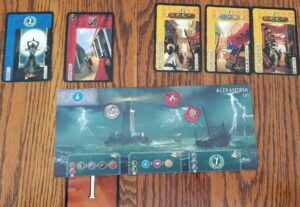
At the start of the game, each player starts with a wonder board (one of the seven wonders of the ancient world, hence the game’s name). This board gives you a starting resource in the upper left-hand corner. It also gives you two to four building stages in order to complete the wonder. Completing the wonder is optional, but each build stage gives you a powerful benefit. To build a wonder slot, you must sacrifice a card from your hand. If there is ever a turn where your hand doesn’t contain a beneficial card to play, that’s the turn to build a stage of your wonder.
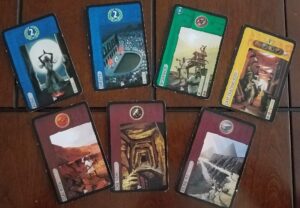
In order to play cards into your city or to complete wonder stages, you will need resources. Your wonder provides one but you will need to acquire more. Some of the card types you can play are resource cards (brown) and specialty resources (grey). Many of these, especially from the first era, don’t cost anything to build, making those some of the first you build. Others cost money. You start with three money so you can build some of those right away.
If you want to build something but lack the resources, you can buy from your neighbors. You can only buy from your left and right neighbors. With three players, this means everyone can buy from everyone else. If you’re playing with four+ players, you can’t buy from the person sitting across from you.
Buying resources requires money as you must pay two per resource you need. The reverse is also true as your neighbors will often need to buy from you. Some cards you play will give you more money to use and you can also sacrifice a card for three money instead of building something. It can be handy to do this just to burn a card out of a hand that you can’t afford and you don’t want your neighbor to play next turn.
The final option for building cards is through ‘linking’. Some cards will have other cards listed on them in the lower right-hand side. If you come across that card later, you can build it for free. This is very handy for acquiring some of the more powerful later era cards and building a synergy of cards.
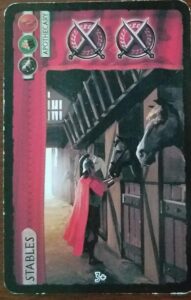
There are seven types of cards in the game (sensing a theme yet?). We’ve discussed the brown and grey cards already which provide resources. Yellow cards are themed around money, trading posts and markets. They provide you with money directly sometimes, can reduce the cost of purchasing resources, and a few provide resources exclusively for yourself.
Blue cards are civic cards such as temples and government buildings. Each type of card provide ways to earn victory points (aside from brown and grey) but these are the most direct as they all have victory points printed on them. Some of the most valuable point cards are the third era blue cards.
Red cards are military. They do not provide points directly but rather, award points at the end of every era to whomever has the military advantage over their neighbors. Like purchasing resources, this only applies to your direct neighbor, not those across from you. If you have more military than your neighbor, you gain a token giving victory points and they get a token worth negative victory points. Each negative token is always -1, so if you never build any military and both your neighbors do, you’ll end up with -6 points at the end. The positives go up through the eras. The first era only awards one point, second era three points and third era five points. If you beat both neighbors every era, you could acquire eighteen points from military.

The green cards are science buildings, libraries, universities and schools etc. Each card has one of three symbols. For each set of all three symbols you get seven victory points. Each symbol itself is worth one point per copy. So one is worth one. Two copies, each is worth two for four points total. This can ramp up quickly if you dive hard into it. But be wary, if other players see what you’re trying they’ll know exactly what cards to burn from a hand to build their wonders or get money, just to deny you points.
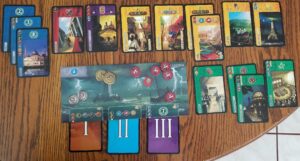
The final set of cards are purple guilds. These cards award points based on other cards played. For example, one gives you points for every red military card player by your neighbors. Unlike the other cards, the guilds are randomized at the start of every game so you won’t have the same set every time you play. Since these don’t appear until the third era you can’t build your city with the goal of getting a specific guild, as it may not be in the game. Guilds can be very powerful or minimal depending on which ones show up and how everyone has built their cities.
Production- B+
Each of the games components are well enough made. The cards are large which, is nice for the art but this means that they’re bigger than standard cards. They will wear out quickly with frequent shuffling and finding good card sleeves for them are difficult.
The cards themselves have all the relevant information on them in an easy to read manner. Once you learn the symbology, you can tell at a glance what each card does. They also have a small number on the bottom which separates them by number of players. Cards are added or removed based on how many players, as you need seven cards per era per player.
The box comes with a storage system for all the components to be stored in its own compartment. There are slots for each of the three eras with compartments underneath for the money tokens. Another bin holds the score sheets and wonder boards. This makes cleanup easy.
There are cards intended to be used for randomizing which wonder everyone starts with. We ended up using those as dividers separating our era stacks since we typically play with three players and don’t want to sort out the 4+ player cards each game. It is easy enough to use the wonder boards themselves to randomize the wonders.
Theme- A
Thanks to the large wonder board you start with, the game does a remarkably good job of feeling like you are building a great wonder and surrounding city. The artwork for the boards and the cards give you a sense of what you are building without detracting from the gameplay. Too often games have to sacrifice one over the other but Seven Wonders gets the right balance.
Expansions- Many
There are quite a few expansions for 7 Wonders out there. I have not tried any of them but some look appealing. The Leaders expansion adds leaders to the game which are new cards you gain at the start. It seems straightforward enough with just new symbols to learn. The Cities expansion does not look appealing as one of the nice aspects of 7 Wonders is, while competitive, each player is more or less playing their own game. You can burn a card for your wonder specifically to deny another player the chance to get that card, but that’s the extent of your ability to affect others. You need to pick a card to burn in that case so it’s not even very cutthroat. Hard to say how cutthroat Cities becomes but I wouldn’t want the game to veer too far away from the city building aspect.
Conclusion- A
Despite all the levels of complexity for scoring and decisions you ‘re faced with each round in picking cards, this is not a long game. Each era takes six turns and they go quick once you get a handle on what each card can do for you. It works well with three or seven players, though once you get over three the games dynamic does chance significantly. But unlike a lot of games, it doesn’t go significantly slower by adding more players. Each round is more or less the same length.
There is a learning curve to playing well, but that doesn’t serve as a roadblock. Mechanically, all you need to learn is to pick a card from your hand that you can afford to play. Once you’ve learned that, the strategy aspect comes with time.

Wayne Basta
Latest posts by Wayne Basta (see all)
- X-Wing Tier List – Rebels - May 10, 2023

